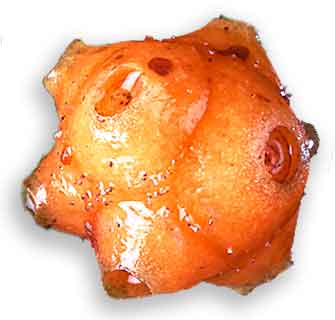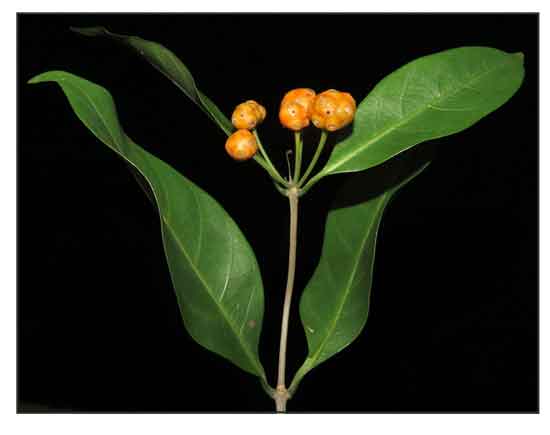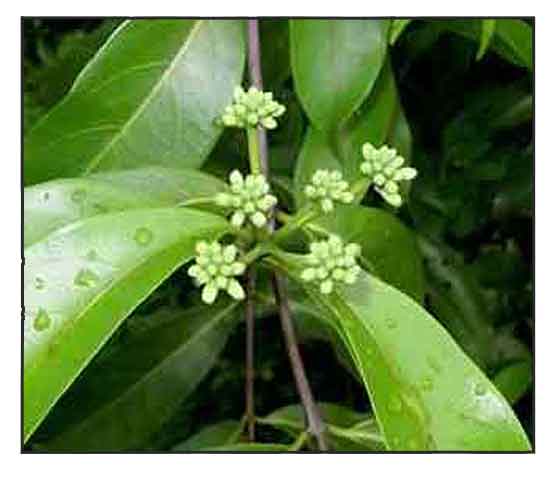 Gen info Gen info
- Gynochthodes is a genus of flowering plants in the family Rubiaceae. The genus is found from Madagascar to tropical and subtropical Asia and the Pacific region.
- Etymology: The specific epithet umbellata derives from Latin, referring to the branches of flower clusters arising from the same point.
 Botany Botany
Nino is a large, diffused shrub, climbing by long, hairy, slender branches. Leaves are elliptic, 8.5 to 13 centimeters long, 3.5 to 5 centimeters wide, smooth on the upper surface, hairy beneath,and pointed at both ends. Inflorescences occur in stalkless terminal umbels about 1.5 centimeter in diameter. Corolla is almost notched, with a bearded throat; the corolla-tube is short, being less than 5 millimeters long. Fruit is compound, 2 to 2.5 centimeters in diameter, and irregularly lobed.
Distribution
- Native to the Philippines.
-
In Cagayan, Zambales, and Sorsogon Provinces in Luzon; and in Mindoro and Culion, In thickets and forests at low altitudes
- Also native to Andaman Is., Assam, Bangladesh, Bismarck Archipelago, Borneo, Cambodia, China, Hainan, India, Japan, Jawa, Laos, Malaya, Marianas, Nansei-shoto, New Guinea, Queensland, Solomon Is., Sri Lanka, Sumatera, Taiwan, Thailand, Vietnam. (3)
- A climbing shrub growing primarily in the wet tropical biome. (3)
 Constituents Constituents
- Roots yield a yellow dye.
- Root-bark contains a glucoside, morindine, and the coloring matter, morindone.
- Various leaf extracts yielded flavonoids, phenolic compounds, alkaloids, steroids, tannins, and carbohydrates. (see study below) (4)
- Nutrient analysis of fruits yielded carbohydrates (6.98 g/100g fw), protein (2.68 g/100 g fw), crude fat (0.13 mg/g dw), and crude fiber (32.58%). Vitamin C content was 25 mg/100 g fw. (6)
- GC-MS analysis of leaf extract yielded 32 compounds, with stereols, stanols, and terpenoids as the most prominent compounds.
Major compounds detected were 9,19-cyclolanost-24-en-3-ol (16.09%), 2,5,5-triphenyl-4-methoxyimidazole (10.87%), β-Sitosterol (8.81%), stigmast-4-en-3-one (7.26%), phytol (5.62%). (7)
- Study of aerial parts isolated 16 undescribed quinones -- 10 anthraquinones (umbellatas A-J), one naphthohydroquinone (umbellata K), one naphthohydroquinone dimer (umbellata L), and four dinaphthofuran quinones (umbellatas M-P). (see study below) (9)
- GC-MS analysis of antioxidant rich ethanolic leaf extract yielded 19 phytocompounds -- 1,2-Benzenedicarboxylic acid, diethyl ester with a percent area of 94.98%, Guanosine (0.79%), Hexadecanic acid (0.72%), phytol (0.47%) were found to be predominant. Elemental mineral analysis yielded essential elements such as Fe (5.65±0.58 ppm), Zn (0.74±0.05 ppm), Mn (0.46±0.04 ppm), and trace amounts of following non-essential elements (heavy metals) Cu (0.87±0.05 ppm), As (0.002±0.00 ppm), Cd (0.08±0.01 ppm), Pb (0.03±0.00 ppm), Hg (BDL). (see study below) (10)
Properties
- Roots considered purgative.
- Studies have shown antibacterial, mast-cell stabilizing, anti-anaphylactic, anticancer, antioxidant properties.
Parts used
Roots, leaves.
 Uses Uses
Edibility
- Ripe fruits are edible; eaten raw.
-
In India, unripe green fruits are used in curries.
Folkloric
- Boiled roots applied for dropsy.
- In America, roots used as violent purgative.
- Leaves, in conjunction with certain aromatics, used as decoction for diarrhea and dysentery.
- Decoction of leaves and roots used as vermifuge for children.
- In Western Ghats region of Kerala used for treatment of diabetes, high blood pressure, muscle aches, and pains. (4)
- In traditional Indian medicine, decoction of roots and leaves used for treating intestinal pains, diarrhea, dysentery, indigestion, syphilis, and gonorrhea. (4)
- In Vietnamese folk medicine, used for furuncles, dysentery and skin diseases. Aerial parts used for fever, cough, stomachaches, rheumatism, and acute hepatitis. (4)
Others
- Rope: Stems used for making rough ropes.
- Dye: Roots yield a yellow dye.
Studies
• Antibacterial / Leaves: Study investigated the antibacterial activity of various leaf extracts of Morinda umbellata against ten different bacterial species, viz., Bacillus megaterium, B. subtilis, E. coli, K. pneumonia, M. luteus, P. aeruginosa, S. typhi, S. flexneri, S. aureus and S. epidermis. Solvents of ethanol and methanol extracts showed antibacterial activity against maximum number of bacterial species tested. (2)
• Mast Cell Stabilizing / Anti-Anaphylactic Effect / Leaves: Study evaluated different solvent extracts of M. umbellata leaves for mast cell stabilizing and anti-anaphylactic effect. Leaf methanolic, n-hexane and chloroform extracts exhibited significant protection against egg albumin induced peritoneal and mesenteric mast cell degranulation. In active paw anaphylaxis, animals treated with ethanolic and n-hexane extracts exhibited significant reduction in ovalbumin induced paw edema. Phenolic compounds and flavonoids in leaves may have contributed to the inhibitory effect on antigen induced mast cell degranulation and active paw anaphylaxis in Wistar rats. (see constituents above) (4)
• Production of Anthraquinone by Callus Culture: Study evaluated the secondary metabolite (anthraquinone) production in callus culture of G. umbellata using invitro leaves. Results showed callus culture is an effective method for the production of anthraquinone invitro in G. umbellata. Anthraquinone production through invitro leaf segment derived callus culture is a viable system for the production of pharmacologically and industrially important natural plant pigment. (8)
• Cytotoxic Quinones Against Human Cancer Cell Lines / Aerial Parts: Study of aerial parts isolated 16 undescribed quinones -- 10 anthraquinones (umbellata A-J), one naphthohydroquinone (umbellata K), one naphthohydroquinone dimer (umbellata L), and four dinaphthofuran quinones (umbellatas M-P). Four of the unknown quinones, umbellata A, H, K and M, showed potent cytotoxic effects against A431, A2780, NCI-H460, HCT116, HepG2, and MCF-7 human cancer cell lines wit IC50s ranging from 1.3-7.1 µM. (9)
• Antioxidant / Chemo-Profiling / Elemental Analysis / Leaves: Study evaluated various extracts of Morinda umbellata for antioxidant potentiality, phytochemical profiling, and elemental analysis. On antioxidant evaluation, maximum 50% inhibitory concentration was seen with ethanolic and methanol extracts at 17.92 and 19.35 µg/ml, respectively, which was four time higher than standard ascorbic acid. (see constituents above) (10)
• Anti-Inflammatory: Study evaluated the effect of active fraction (MUAF) on various inflammatory mediators using lipopolysaccharide (LPS) induced invivo model in Wistar rats. Study demonstrated significant inhibition of proinflammatory cytokines. The MUAF suppressed overexpression of TNF-α, IL-1ß, IL-6, iNOS, COX-2 possibly via downregulating NF-xB activation. Oral acute toxicity testing suggested non toxic nature of MUAF. (11)
Availability
Wild-crafted. |

![]()




 Botany
Botany
 Uses
Uses